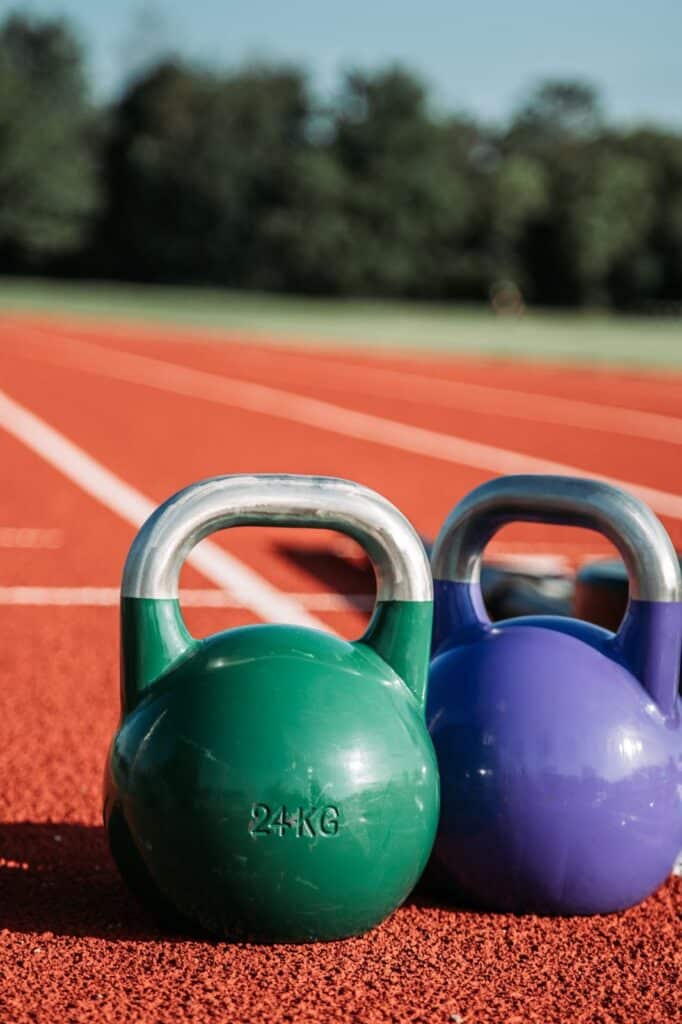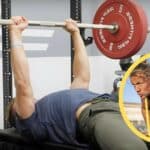Are you looking to get a good workout with minimal equipment? If so, look no further than incorporating kettlebell exercises and moves into your daily workout.
In this article, we’ll explore the perfect number you need to increase strength and agility. We’ll also cover exercises and moves you can use no matter your level of fitness.
By the time you’re done reading, you’ll have an answer to the question, “how many kettlebells do I need?”
Jump to:
Why You Need To Master Kettlebell Exercises
Kettlebells are a staple for many Crossfit workouts of the day (also known as a WOD). In fact, their use dates back to early 18th-century Russia where they proved arm strength.
Their population stems from their versatility. Training with kettlebells engages many muscle groups. These dynamic movements also increase your functional core and grip strength.
According to Harvard, these weights also have the benefit of improving your posture, core, and balance. No matter your current fitness level, there are kettlebell movements you can use.
Kettlebell training exercises work out hundreds of muscles and flexible movements with less time. This makes your workout more efficient.
How Many Kettlebells Should I Have?

When it comes to adding gear to your workout collection, there are many factors to consider.
Ask yourself, what is your current level of fitness and skill level? If you’re a beginner or unfamiliar with these basic exercises, one is all you’ll need for the foreseeable future.
In fact, basic training moves only need one piece of equipment. Pick one weight that pushes you, but is still doable for the moves we’ll discuss below.
Start with a few basic exercises and work your way up to adding heavier weights or more weights into your routine as you progress. Focus on using correct form before moving on to hard moves and heftier weights, since poor techniques lead to injury.
So the answer to our question is: it depends on you, your goals, and your fitness level.
Benefits of 1 Kettlebell
Several workouts use only one bell. This one small piece of gear can give your muscles a range of moves for your workout goals.
Exercises with 1 Kettlebell
Focus on mastering some of these key moves to see gains in core strength, proper technique, and balance. Or challenge yourself by incorporating difficult moves with higher weights into your routine.
Exercises for Beginners
If you’re a beginning kettlebell user, make sure you start with a lighter weight. Focus on the mechanics of these basic moves before you move on to more complex ones.
- Kettlebell swing – With both hands gripping the handle, hold the kettlebell down in front of you with arms extended. Bend your knees and do a two-handed swing with the kettlebell through your legs in a pendulum motion. Drive through your hips to swing straight in front and overhead, using momentum to complete the arch. Repeat.
- Goblet Squat – Grip the kettlebell handle with both hands and hold it under your chin with your elbow tucked in as you complete a squat.
Exercises for Seniors
- Slingshot – Start with the kettlebell in front of you and use one arm to swing it around to your back, where you will switch hands. You will then continue rotating, switching hands at the front and back.
- Halo – Grip with both hands as you rotate the weight around your head in a clockwise motion. Then switch directions and repeat.
- Deadlift – Hold the curved handle with both hands, and extend your arms past your hips. With your back flat and feet hip-width apart, lower the kettlebell to the ground, bending at the hips. Raise back up and repeat.
Advanced Kettlebell Exercises
- Turkish Get-Up – Start on the floor holding a kettlebell overhead with one hand. On the same side, bend your knee, while the opposite arm stretches to the side. Keeping the bell overhead, sit up on your elbow, then push up to your hand. Tuck your extended leg underneath you until you’re on your knees, and push to a standing position. Lower yourself in reverse order and repeat. Proper form here is key.
- Kettlebell Snatch – Start with the weight on the floor and your body bent at the hips. In one ballistic movement, grip the handle and pull it straight overhead and into a standing position.
- Pistol Squat – Holding the weight like in a kettlebell goblet squat, balance on one leg with the other extended in front. Lower yourself to a squat and then raise yourself back up again.
Benefits of 2 Kettlebells
The biggest benefit of working out with two kettlebells is that you have a chance to see bigger gains. These powerful moves will push you to take your routine to the next level.
As a reminder, don’t move on to exercising with two bells until you’ve mastered the moves with one. Jumping in with heavier weights and harder moves is a sure recipe for injury.
Double Kettlebell Exercises
If you’re looking to challenge yourself and see gains at the same time, switch up your routine. Include some of these more difficult moves in your next WOD.
Exercises for Beginners
- Lunges – Hold a kettlebell in each hand down by your hips with arms extended. Standing in a split squat and lower your back knee to the ground. Focus on keeping your leg over your ankle to avoid injury.
- Kettlebell Row – While standing, bend at the hips with a kettlebell in each hand. Keep your back straight, then pull both up towards your armpit, staying as close to your body as you can. Then lower and repeat.
Exercises for Seniors
- Step Ups – an easy, lower impact exercise, hold a weight in each hand and find a low step on which you can get on and off. Step up first with your right leg, then your left, making sure to stand up completely at the top. Then step down and repeat.

Advanced Kettlebell Exercises
- Single Leg Deadlift – Hold a weight in each hand, arms down. With your knees bent and back flat, balance on one leg and lower them to the ground. Keep one leg extended behind you. Return to the starting position and repeat, alternating sides.
- Double Clean, Squat, and Press – begin with a pair in each hand and complete a clean. While still in the rack position, squat down making sure to drive your hips back. From the bottom of your squat, explode up through your heels. Driving the kettlebells up overhead before returning to the starting position.
- Alternating Kettlebell Clean – begin with one kettlebell in the clean position and the other extended arm’s length down. Using your hips, lower the upper kettlebell while cleaning the other up. Repeat.
What Weight of Kettlebell Do I Need?
The next important question we need to answer is what weight or weights you may need. Again, this answer can vary.
If you’re at a beginner level of strength training, start with a lighter kettlebell size and work your way up. If you’re already familiar with these moves, you could start with a heavier kettlebell. Make sure it’s one that will push you without causing injury.
Kettlebells for Men
A man’s standard kettlebell workout would be 16-kg and 24-kg kettlebells. Most WODs use competition kettlebells and would use a heavier bell for most, if not all, moves. The size of kettlebells also depends on the exercise you’re using them for as well.
Take into consideration your own fitness and experience level. It may make more sense for you to start at a lower weight (16 kg for example) and move up as your strength and balance improve with consistent workouts.
Kettlebells for Women
For women, 16-kg kettlebells are standard for most moves. If you’re a female beginner, start with an 8-kg kettlebell and move up as you’re able.
Bells come in several options of weights and sizes to fit your need, which is great for women of all fitness levels. Try a few moves with different weights to make sure you’re challenging yourself without risking injury.
Sizes of kettlebells for athletic women will vary for inactive women who are getting started.
Should My Kettlebells Be the Same Weight or Different?
The answer to the question, “should my kettlebells be the same weight or different?” is not straightforward. The simple answer is that the type of kettlebells will depend on the type of exercise you’re wanting to do.
For example, double kettlebell rows need two kettlebells of the same weight to work both sides. The same goes for most of the double kettlebell moves we discussed above. To get equal gains on both sides, it’s best to buy two kettlebells of the same weight.
If you’re focusing on single kettlebell moves, then it makes sense to buy kettlebells of different weights that you can use as you improve. There are even adjustable kettlebells you can get for this exact purpose.
Progressing From 1 Kettlebell to 2 Kettlebells
If you want to challenge yourself and work up to using two weights, follow this progression:
- Using a lighter weight, master the advanced moves for one kettlebell. These include Turkish get-ups, pistol squats, and a kettlebell snatch.
- As you perfect your correct kettlebell technique, increase your weight. Make sure your mechanics remain solid as you work your way up.
- Start simple double kettlebell moves using a lighter weight.
- As you continue to make forward strides in your abilities, increase the weight to continue challenging yourself.
Are You Ready for Your Kettlebell Workout?
Kettlebell training is a great way to add dynamic strength moves and agility into your workout routine. No matter where you are on your fitness journey, these moves are sure to challenge you.
From goblet squats to kettlebell swings to presses, switching out your barbells for some quality kettlebell moves will help you reach your fitness goals. You’ll get a killer workout, muscle building, and complex movements all in one with less training time.
Ready to get started? Block out time on your schedule for your next kettlebell workout. You’ll start seeing gains before you know it.















